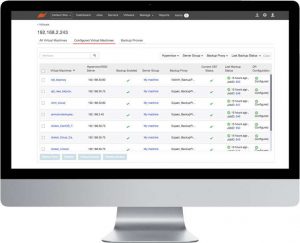Druva Cloud Data Protection and Workload Mobility Portfolio With Hyper-V Support
Include all major virtualization environments under single control plane for workload mobility, archival and DR with no additional hardware.
This is a Press Release edited by StorageNewsletter.com on September 28, 2017 at 2:21 pmDruva, Inc. is adding Microsoft Hyper-V support via Phoenix, a cloud backup and archival solution.
Click to enlarge
This adds Hyper-V to Druva’s lineup of supported VM environments, which already includes VMware vSphere and Nutanix, Inc. Support of these platforms indicates Phoenix now integrates with 75% of VM environment providers.
“We are entering an era where the use of multiple virtualization platforms will be commonplace as enterprises continue to expand their environments from on-premises, to a variety of cloud environments. Workload mobility and multiple hypervisor support is key to providing a single control plane for data protection and management, regardless of where those workloads reside,” said Dave Packer, VP, product and alliance marketing. “By adding Hyper-V support, our Phoenix product can streamline policy management and aid in the orchestration of these distributed workloads by supporting the most common hypervisors deployed today.“
Through Hyper-V integration, Phoenix allows customers to perform:
-
Incremental performance backups via Windows Volume Shadow Copy Service (VSS) and Microsoft Resilient Change Tracking (RST) combined with the company’s patented global deduplication ensuring timely and efficient backups are achieved that minimize resource impact;
-
Granular VM recovery, Hyper-V customers can restore full environments, or down to the file level to optimize RTOs;
-
Unified policy management, the company’s single control plane, leveraging the public cloud, eliminates the need for a costly multi-vendor approach;
-
Cloud-based DR, organizations can configure and then immediately boot VMs in the cloud for failover and testing;
-
Cross environment workload mobility, enables organizations to move workloads cross hypervisor to support different business needs (e.g. test and dev, migration)
“The freedom to choose between virtualization platforms for workloads and data is one of the strategic benefits of a modern, hybrid infrastructure,” said Steven Hill, senior analyst, storage technologies, 451 Research. “The key to leveraging that flexibility lies in adopting a DR and BC and data protection platform that natively spans multiple hypervisors and provides a common, policy-based model for management, security and data protection.“
This adoption supports both users loyal to the Microsoft stack – including legacy Hyper-V versions – and those operating in mixed environments. Phoenix for Hyper-V enables companies to streamline their restoration process and infrastructure by centralizing the backup and recovery of globally distributed environments through the cloud. This integration coupled with agentless approach to backup means that all backup software is maintained centrally, versus at the host, simplifying licensing and reducing administrative and compatibility burden. Additionally, no explicit permissions need to be provided to members of the backup team, giving the team secure and speedy backup.













 Subscribe to our free daily newsletter
Subscribe to our free daily newsletter
